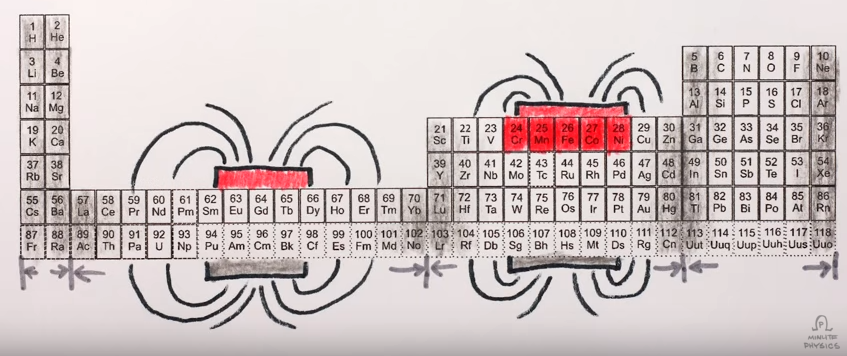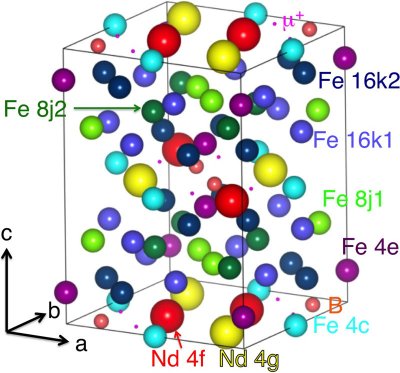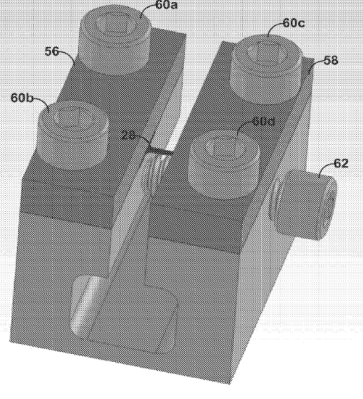Since their relatively recent appearance on the commercial scene, rare-earth magnets have made quite a splash in the public imagination. The amount of magnetic energy packed into these tiny, shiny objects has led to technological leaps that weren’t possible before they came along, like the vibration motors in cell phones, or the tiny speakers in earbuds and hearing aids. And that’s not to mention the motors in electric vehicles and the generators in wind turbines, along with countless medical, military, and scientific uses.
These advances come at a cost, though, as the rare earth elements needed to make them are getting harder to come by. It’s not that rare earth elements like neodymium are all that rare geologically; rather, deposits are unevenly distributed, making it easy for the metals to become pawns in a neverending geopolitical chess game. What’s more, extracting them from their ores is a tricky business in an era of increased sensitivity to environmental considerations.
Luckily, there’s more than one way to make a magnet, and it may soon be possible to build permanent magnets as strong as neodymium magnets, but without any rare earth metals. In fact, the only thing needed to make them is iron and nitrogen, plus an understanding of crystal structure and some engineering ingenuity.
Getting Everything Lined Up
To start things off, what even is a permanent magnet? Like many simple questions about nature, there’s no easy answer that doesn’t require a fair amount of hand-waving. Even physicists eventually get to a point where their answer comes down to, “We just don’t know.” But that doesn’t mean magnetism is a complete mystery, and the things that we do know about it are pretty straightforward, and actually help in understanding how both rare earth magnets and their alternatives work.
We’ve taken a stab at the basics of magnetism before, but to summarize, any charged particle, like an electron, has what’s known as an intrinsic magnetic moment, meaning they act like little magnets. In atoms with filled electron shells, these magnetic moments cancel each other out because each pair of electrons have moments that point in opposite directions. But in atoms with unpaired electrons in their outer shells, there’s nothing to cancel out the magnetic moments, which means these elements are magnetic. These elements tend to come from two specific areas of the periodic table: the d-block metals like cobalt, nickel, and iron, and the f-block actinides lanthanides, which include the rare-earth metals like samarium, neodymium, and praseodymium.

There’s more to a magnet than just where its ingredients came from on the periodic table, though. Magnetism is about getting all those intrinsic magnetic moments lined up and acting in the same direction. Just like the electrons in an atom of a magnetic element have to not fight each other, the atoms must also arrange themselves so that their magnetic moments are all pointing the same way. This is referred to as having a high magnetic anisotropy, and is one of the characteristics of strong magnets. Rare-earth metals like neodymium have very high magnetic anisotropy, which contributes to the strength of rare-earth magnets.
But rare-earth metals by themselves actually make pretty poor magnets, at least on a practical level. This is due to their relatively low Curie point, which is the temperature above which a substance loses its magnetic properties. At room temperature, a pure bar of neodymium wouldn’t be a magnet at all. In fact, it would need to be chilled to below 20 K to have any magnetic properties. To get around that, rare-earth metals are mixed with other ferromagnetic elements to form alloys that have a strong magnetic coercivity while also having a decent Curie point. The most common rare-earth magnet alloy, a combination of iron, neodymium, and boron, has a Curie temperature in the range of 300-400°C, depending on the exact mix of elements.
The Power of Crystals

Going further down the rabbit hole of magnetism requires getting comfortable with the concepts of crystallography. This is a fiendishly complicated subject, with nomenclature and terminology that’s confusing because it seems like it’s the same as standard chemical formula notation, but it’s clearly not. A full understanding of how adding neodymium to iron makes a powerful permanent magnet, and how making a powerful magnet without any rare earth is possible, would require a deeper dive into crystallography than we have space for here. Luckily, the basics will suffice, along with a little hand waving. And credit is due here to my friend Zachary Tong, who pitched in and helped me get my head around these difficult topics.
The crystal structure of a substance is all about how its atoms pack together into ordered arrangements. The building block of crystals is called the unit cell, which is the smallest possible repeating unit of the crystal. For neodymium magnets, the unit cell formula is Nd2Fe14B. This is confusing when you look at schematics of the crystal structure, which show far more than two neodymium atoms and fourteen irons. But the important thing here is that the unit cell shape of Nd2Fe14B is what’s known as simple tetragonal (ST), which sounds like it should be a pyramid but is actually a cube that has been stretched along one axis. This axial asymmetry gives each crystal a high degree of magnetic anisotropy, which is part of the reason that neodymium magnets are so strong. The other factor is that the neodymium boosts the number of unpaired electrons in the alloy compared to plain iron alone, which makes for a stronger overall magnetic moment.
Rust Plus Fertilizer
So with all this in mind, how can the addition of nitrogen to iron make magnets that have properties comparable to rare-earth magnets? Again, it’s partly to do with the crystal structure, and partly to do with the electronic structure of the elements in the alloy. Iron normally has a unit cell that’s either body-centered cubic (BCC), where eight iron atoms are centered on the corners of a perfect cube and one atom is at the dead center, or face-centered cubic (FCC), with an atom at each corner and one in the center of each face. But when nitrogen is alloyed with iron, the cubic unit cell structure gets distorted in what’s known as a body-centered tetragonal (BCT) structure. What happens is that the nitrogen atoms get incorporated into the interstitial space of the crystal, elongating one side. This asymmetry is similar to the tetragonal crystal structure of neodymium magnets. Coupled with the ferromagnetic properties of iron, the result is a strongly magnetizable alloy without the need for rare-earth metals.

Iron nitrides are nothing new. Nitriding processes, such as gas nitriding by exposing heated steel to ammonia, have been used for steel finishing for more than a century. The more complex iron nitride α”-Fe16N2 was first discovered in 1951; its magnetic properties were explored in the early 1970s and again in the 1990s as part of the search for new and better heads for hard drives and other magnetic recording media.
This alloy showed promise in magnetics but proved difficult enough to work with that results weren’t easily reproducible, so interest in α”-Fe16N2 waned until the late 2000s, when methods of producing thin films of the material were developed. These experiments showed that these films may have two to three times the magnetic energy product, a key measurement in determining the strength of a magnet, than neodymium magnets. Along with all the other properties that have been discovered, this makes iron nitride an excellent candidate for a new kind of magnet without rare earth elements.
How to Make a Magnet
With most scientific discoveries, there’s a long way between the lab and a practical commercial product, and this is true with iron nitride magnetics. A lot of the recent advances in iron nitride permanent magnets have come from the lab of Jian-Ping Wang in the Department of Electrical and Computer Engineering at the University of Minnesota. Four different methods for synthesizing bulk α”-Fe16N2 material have been developed there, some of which show some promise in the industrial environment.

The earliest methods of making α”-Fe16N2 required a high-temperature process with rapid quenching of the nitrided sample, which doesn’t lend itself to scaling up to industrial production. One of the first attempts to get around this was the use of ion implantation. This technique, in which ions are accelerated in a vacuum by a strong electric field and slammed into a target substrate, is common in semiconductor manufacturing, where it is used to dope silicon wafers. To make iron nitride magnets, pure iron foils 500 nm thick are mounted on a silicon substrate and bombarded with atomic nitrogen ions. This is followed by a series of annealing steps, which activate the implanted nitrogen and produce a thermal strain in the material that traps the nitrogen inside the foil’s crystal structure, producing the distortion necessary. Foils of α”-Fe16N2 made this way show hard magnetic behavior, and practical magnets can be made by stacking the foil into layers and binding them into a single structure.
Low-temperature nitridation is also possible, using iron oxide nanoparticles as a starting material. In this method, the particles are treated with ammonia gas to get the nitrogen into the crystal structure. Alternatively, iron oxide can be mixed with ammonium nitrate in a planetary ball mill; after a few days of milling at 600 rpm, the stainless steel balls decompose the ammonium nitrate into elemental nitrogen, which diffuses into the iron nanoparticles. The resulting α”-Fe16N2 is then separated by magnet and can be formed into solid shapes. This method seems like it would easily scale up to an industrial process.
High-temperature nitridation of iron foils and wires is also possible. This method uses ribbons of an iron-copper-boron alloy and exposes it to an atmosphere of ammonia and hydrogen at 550°C for 28 hours, followed by a rapid treatment at 700°C and an ice-water quench. A variation on this method is the strained-wire approach, where high-purity iron is melted in a crucible with urea. The nitrogen that decomposes from the urea diffuses into the iron, and the mixture goes through heat treatment and quenching steps before being hammered flat and cut into strips. The strips are put into a straining device and stretched during an annealing step, which serves to elongate the crystal structure and trap the diffused nitrogen.
Strong permanent magnets aren’t the only thing that iron nitrides might be good for. Soft magnetics, which are materials with lower coercivity and are good for things like the cores of transformers and inductors, or for read-write heads of magnetic media, may also be possible by doping α”-Fe16N2 with elements like carbon, oxygen, or boron. These dopants reduce the magnetic anisotropy of the crystal structure, making it harder to permanently magnetize them while maintaining high saturation magnetization.
There’s a lot of promise to so-called “clean-earth” magnets — so much so that the University of Minnesota has spun off a company, Niron Magnetics, to turn the concepts and processes into products. We’re keen to see where this technology goes, and look forward to powerful magnets made with nothing but rust and fertilizer.
















A really interesting article. I studied crystallography as part of a Geology degree and it is very challenging to visualise some of the more complex silicate structures found on rock minerals. Good to see research that may reduce the chances of conflict over limited resources especially as demand for magnetic materials increases.
Great writeup! I had never heard of nitrogen+iron magnets before. Sounds promising.
Ah what an interesting rabbit hole to dive into. If this really pans out as a practical manufacturing process it will perhaps be the most ground breaking thing in decades.
If I’ve learned anything about chemistry then it’s that it’s only a matter of time before a method is discovered. With enough stupid monkeys thinking and doing, eventually one will figure out how, possibly on accident but it will happen.
I often ponder if there is a program that can predict the properties of a structure as well as simulate our methods of constructing it. This could go a long way toward finding both possibly interesting structures as well as those that are easily constructed. Testing the accuracy of the predictions would no doubt highlight the flaws in our understanding of physics.
AI assisted chemical pathway discovery is (will be) a thing: https://www.nature.com/articles/d41586-018-03977-w
If nothing else, it will make more powerful motors so electric cars will go much further with the same battery charge.
Stronger magnets would improve the efficiency of a motor, or allow for a more powerful motor of a smaller size. EV motors are already at about 90% efficiency, though. A lot of EVs use induction motors which don’t even have permanent magnets in them. Stronger magnets aren’t going to improve range by very much, but a gain of 1-2% is better than a stick in the eye.
It’s all about $$$, sustainability, and China’s stranglehold on the supply of NdFeB. If Niron can pull it off, it’s a game changer.
I wonder what the curie temperature for the Iron Nitride magnets will be? If it’s anywhere near close to AlNiCo (840c) according to google with the strength of a Nd magnets it’s a clear winner
My main concern is how long it’ll take for these magnets to reach the general public. Because I kinda have a need for strong magnets with high Curie temperatures right now. XD
” A variation on this method is the strained-wire approach, where high-purity iron is melted in a crucible with urea. ”
Ah, finally a good use for bathrooms.
“There’s a lot of promise to so-called “clean-earth” magnets — so much so that the University of Minnesota has spun off a company, Niron Magnetics, to turn the concepts and processes into products.”
Hopefully the papers are free to read. ;-)
If your pee is that hot you really need to see a doctor!
Re: free to read. It’s kinda journal dependent and kinda funding dependent. In medical and life science, government funded research has to be made publicly available after 6mo. Something like that. If the research is independently funded, but came out of an academic institution’s speciality institute, that’s much harder to figure out.
Wouldn’t be the first time bathroom waste was used for something other than fertilizer. The Romans collected urine and used it as a cleaning agent for clothes.
Dying agent.
To make purple die from snails you need lots and lots of piss.
The stink was one way the upper crust could tell genuine from fake.
Peons didn’t smell like piss all day.
The rich and powerful did.
Still true for Biden.
At last! Magnets are more Irony.
Ball milling ammonium nitrate sounds like a blast.
Yep, all you need is big set of steel balls.
I was thinking the same thing. Folks in Beirut might want to chime in on this topic.
I’m sure it’s safe, as long as you don’t don’t mix it with finely powdered metals and heat it up in a confined space.
Oh, wait…
Above 400°C, it explodes to reform Nitrogen gas.
It’s definitely not impossible to detonate ammonium nitrate, but you’d need some actual detonator to do that, or something similar. It’s not nearly as easy to detonate as many other substances used in many technical processes.
Ammonium nitrate and metal powder equals rocket fuel.
A blast with a radius, no doubt
Another issue with rare earth magnets is that digging the materials makes nuclear waste.
https://en.wikipedia.org/wiki/Mountain_Pass_mine#Environmental_impact
That’s part of the reason why all the REE business shifted to Asia.
Everything about why the US, which has no shortage of not actually rare Rare Earths, relies entirely on imports:
S. 2093 Rare Earth Cooperative 21st Century Manufacturing Act
https://www.youtube.com/watch?v=8mO6hZFGnA8
The bill was not enacted into law. BOUGHT government strikes again.
https://www.govtrack.us/congress/bills/116/s2093/text
Congress finds the following:
(1)Rare earth elements are critical for advanced energy technologies, national defense, and other commercial and industrial applications.
(2)The People’s Republic of China (referred to in this subsection as China) has leveraged its monopoly control over the rare earth value chain to force corporations from the United States, Europe, Japan, and South Korea to transfer manufacturing facilities, technology, and jobs to China in exchange for secure supply contracts.
Mining and processing rare earths creates a lot of poisonous byproducts (pollution). Preventing this pollution is expensive; organizations that cleanly produce pure rare earths are at a competitive disadvantage. Laws created by Congress and enforced by the EPA have thus made it impossible to stay in business producing rare earths in the U.S.A.; similar laws have similar effects in other free countries. Hence China’s monopoly, China does not give pollution prevention a high priority. China does give military and territorial expansion high priority.
The U.S. situation can be looked as as government meddling causing a serious problem which government claims it can fix with more meddling. However, pollution is a real problem that has to be dealt with.
Methods to deal with the conflicting needs of technological and military materials versus a reasonably clean environment, at an acceptable cost, are difficult to develop. Removing frivolous restrictions that increase business costs (like diversity requirements) would be a good start.
It seems like the ball mill approach might be within reach of the home experimenter. Although I suspect it’s more than likely to far easier said than done. Still, it’s pretty tempting to give it a go and see if anything comes of it.
It might – but I wouldn’t.
I found a way to make regular magnets work in a “magnet motor” that can actually produce useful horsepower. With this and monopole magnets I’m sure I can make something even better. Anyone interested in investing? The best part it’s these “motors” are so inexpensive with a very minimal parts list. They will change the world.
Please no evil plots to rule the world. Let’s just change it for the better
So you made… An electric motor?
Not quite sure how you’re going to get your hands on a monopole magnet, either, as they’re mostly hypothetical – unless you happen to have a method to produce room-temperature spin ice at heretofore unseen scales.
Hi John, pls drop a contact.
> the stainless steel balls decompose the ammonium nitrate into elemental nitrogen, which diffuses into the iron nanoparticles.
Why mess around with ammonium nitrate when you could just expose the nanoparticles to N2 gas?
It won’t mix properly.
The original Bessemer process for making steel used atmospheric air to bubble through molten iron to burn the carbon out, and it resulted in the inclusion of a lot of nitrogen in the iron, which simply made low quality steel – not powerful magnets.
When the magnet is made, the materials are mixed together in powder form and then compressed into a lump to sinter them together. Otherwise the different materials would diffuse around and clump together to form entirely different crystal structures and the magnetic effect would be lost.
I apologise for being a periodic table pedant, but “the f-block actinides, which include the rare-earth metals like samarium, neodymium, and praseodymium” is nonsense. These elements are _lanthanides_, named after lanthanum, the first f-block element. The actinides are the second f-block period, starting with actinium – hence the name – and including such familiar devils as uranium and plutonium.
But these “devils” can be quite useful to give us energy during the time the sun is not shining. Of course nuclear fusion would be fine, but it not yet feasible for a power station.
Or, you know, just an honest mistake. Fixed it.
Would it be possible to use these techniques on the rare earths, to further enhance their magnetic properties?
There must be something wrong with the ball mill method, because that sounds like something I could do. If it worked as well as the high temp methods, no one would be fiddling around with stretching tiny little wires after a multi-step 30+ hour heat treat process. Or ion deposition… sure there’s vacuum zapping and annealing, but just stack the foils to make practical magnets. How thick are they? Same as one wavelength of green light. Better get to stacking, and don’t sneeze.
My guess is that there will be strata, with cheap but meh ball mill magnets next to strong hi temp million layer magnets that are 10-100x more expensive.
What I’m looking forward to is finding the new temperature induced failure modes in brushless motors. No more freaking out that your spendy little diy drone power plant might become a doorstop because it got barely hot enough to bake a cake.
How good are Uranium based magnets? The USA makes a fair amount of depleted Uranium I understand.
February 2024.
What is the status now?
When can we by Clean Earth Magnets?